Understanding Your Stretcher Bed Options
A stretcher bed is a specialized medical transportation device designed to safely move patients while providing comfort and stability. Here's what you need to know:
| Stretcher Bed Basics | Description |
|---|---|
| Primary Purpose | Patient transport in hospitals, ambulances, and mortuary settings |
| Key Components | Frame, mattress platform, casters, side rails, and hydraulic systems |
| Common Types | Transport, ambulance, emergency folding, orthopaedic, and mortuary stretchers |
| Weight Capacity | Standard (350 lbs), Bariatric (600-1000+ lbs) |
| Price Range | $150 (basic canvas) to $5,000+ (powered automatic-loading) |
When selecting a stretcher bed, the right choice depends on your specific needs. For funeral directors, mortuary stretchers provide specialized features like multi-level height adjustment, bariatric options for larger decedents, and compatibility with removal vehicles.
These essential tools have evolved significantly from basic canvas carriers to sophisticated transport systems with hydraulic mechanisms and automatic loading capabilities. Modern stretcher beds feature central locking casters, adjustable backrests, and integrated safety systems to protect both the patient and the operator.
I'm Mortuary Cooler, a national-level mortuary cooler supplier with extensive experience helping funeral professionals select the right stretcher bed solutions for their specific facility requirements and budget constraints.
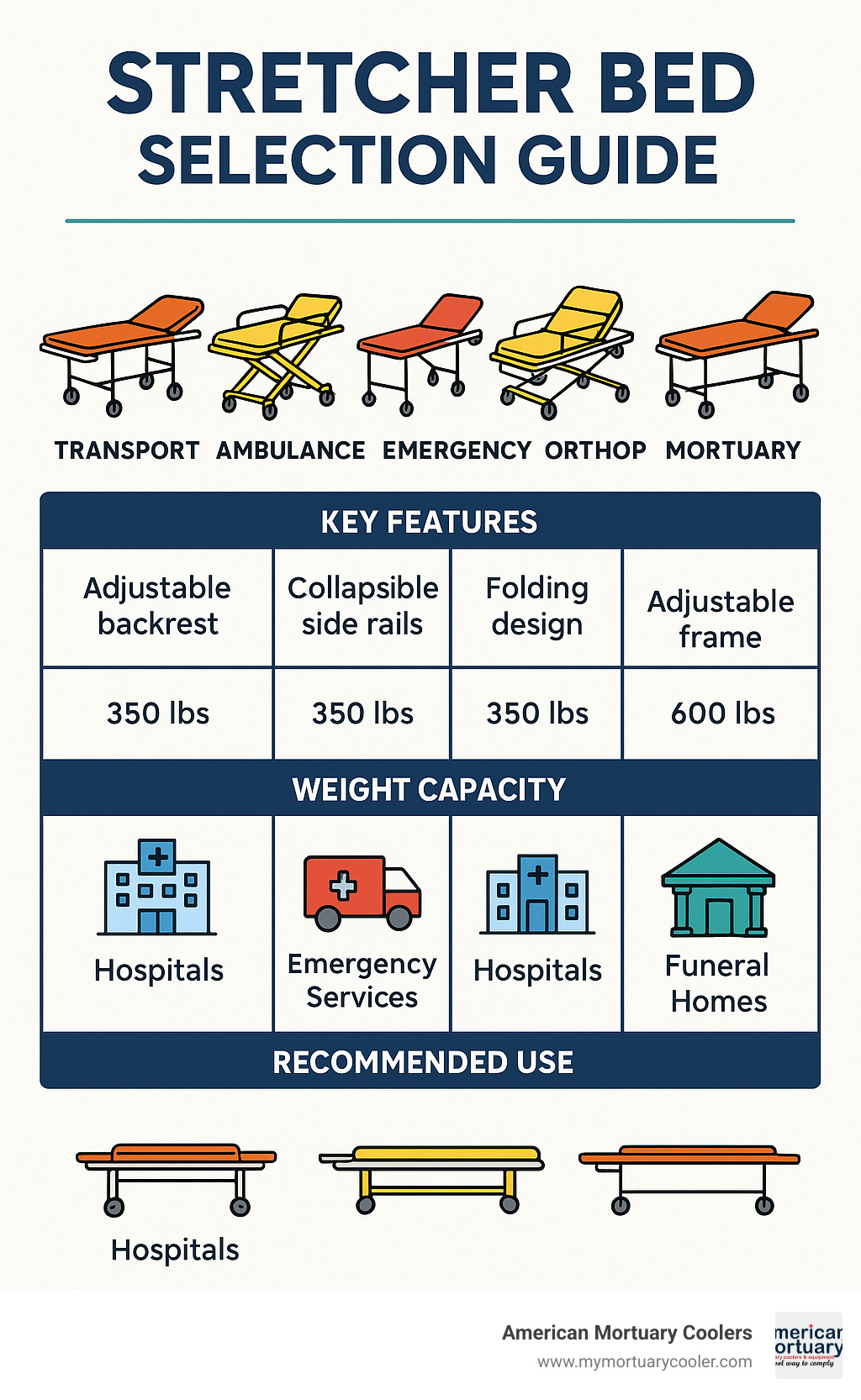
Simple stretcher bed glossary:
What Is a Stretcher Bed? Definition & Core Components
Think of a stretcher bed as the workhorse of patient transport – it's the specialized mobility device that safely moves patients or deceased loved ones while providing stability and comfort. Unlike your bedroom furniture, these beds are built for movement, designed to glide effortlessly through hospital hallways, funeral home corridors, and into transportation vehicles.
When you break down a stretcher bed, you'll find several thoughtfully engineered components working together. The frame forms the backbone, typically crafted from aircraft-grade aluminum or stainless steel that balances durability with lightweight handling. This supports the mattress platform – the surface where the patient rests, often featuring adjustable sections that can lift the head or feet for comfort and medical necessity.
The casters are the unsung heroes of any quality stretcher bed. These specially designed wheels (usually 4-8 inches in diameter) enable smooth movement across different flooring surfaces while including locking mechanisms to keep everything stable when you need to stay put.
"I always tell our funeral director clients to pay special attention to the caster quality," shares our equipment specialist at American Mortuary Coolers. "Those wheels need to roll smoothly when you're navigating tight corners with precious cargo."
Safety features include adjustable side rails that prevent falls while allowing easy access for transfers. Most professional models also incorporate IV pole mounts – essential attachment points for medical equipment during transport.
The height adjustment mechanism might be the most appreciated feature by caregivers and funeral professionals alike. Using hydraulic or electric systems, these allow you to raise or lower the stretcher bed with minimal effort, preventing back strain during transfers and ensuring dignity in care.
Modern designs prioritize ergonomics for both the person on the stretcher and those operating it. Weight capacities vary widely – standard models typically support up to 350 pounds, while specialized bariatric versions can safely handle 1000+ pounds for larger individuals.
Standard stretcher bed vs hospital bed vs gurney
Though people often use these terms interchangeably, there are meaningful differences between a stretcher bed, a hospital bed, and what's commonly called a gurney:
| Feature | Stretcher Bed | Hospital Bed | Gurney |
|---|---|---|---|
| Primary Purpose | Transport between locations | Long-term patient care | Quick transport (often synonymous with stretcher) |
| Mobility | Highly mobile with smooth-rolling casters | Limited mobility, not designed for frequent movement | Highly mobile with emphasis on maneuverability |
| Height | Adjustable, typically 24-36 inches | Adjustable, often lower for fall prevention | Fixed or adjustable, typically at transfer height |
| Width | Narrower (21-30 inches) for doorways | Wider (35-40 inches) for comfort | Narrow for doorways and corridors |
| Weight | Lighter for transport | Heavier, more robust | Lightweight for quick movement |
| Collapsibility | Many models can fold or collapse | Not collapsible | Some models can collapse for storage |
| Side Rails | Simple, primarily for safety | Complex, adjustable for various care needs | Simple safety rails |
| Features | Basic positioning options | Extensive positioning, integrated scales, exit alarms | Basic positioning options |
In everyday American healthcare settings, "gurney" and "stretcher bed" often refer to the same thing. The real distinction is in purpose: hospital beds create a comfortable environment for extended stays, while stretcher beds excel at efficient, dignified transportation.
In the funeral industry, stretcher beds take on specialized characteristics. They typically feature multi-level height adjustment for seamless transfers, reinforced frames to accommodate various weights, vehicle compatibility for removal services, and surfaces designed for thorough cleaning and disinfection.
"When you're caring for someone's loved one, having the right equipment makes all the difference," notes our specialist at American Mortuary Coolers. "A properly designed mortuary stretcher bed allows funeral professionals to provide respectful, dignified care throughout the transportation process."
Main Types of Stretcher Beds and Their Use Cases
The world of stretcher beds is wonderfully diverse, with each design serving a specific purpose in healthcare and mortuary settings. Whether you're rushing a patient to emergency care or providing dignified transport for the deceased, there's a stretcher bed perfectly engineered for the task.
Ambulance & automatic-loading stretcher bed
When seconds count in emergency situations, ambulance stretchers become lifesaving equipment. These specialized stretcher beds feature smooth-operating gas springs that make height adjustments feel almost effortless—crucial when loading patients into ambulances on uneven terrain.
"Automatic loading mechanisms have revolutionized emergency transport," explains an EMS professional I spoke with recently. "What once required two or three personnel can now be accomplished by a single operator, saving crucial time and reducing staff injuries."
Modern models like the MOBI 3D2 allow one-person operation, a game-changer for emergency responders working in limited-staff situations. These stretchers meet rigorous FDA/CE compliance standards and include secure vehicle locks that keep the stretcher firmly anchored during transport—even on bumpy roads or during sudden stops.
The mechanical foldaway legs are particularly clever, automatically tucking underneath before vehicle loading when you activate the handles at one end. Most ambulance stretchers support around 350 pounds, though specialized versions offer higher capacities.
Orthopaedic & scoop stretcher bed
For patients with suspected spinal or skeletal injuries, the orthopaedic or scoop stretcher bed is nothing short of brilliant engineering. These stretchers separate into two split halves that can be gently positioned under a patient without having to roll or lift them—minimizing movement that could worsen injuries.
The rigid design provides excellent spinal immobilization, which is why they're standard equipment for emergency responders handling accident victims. A medical trainer I interviewed emphasized proper technique: "The weight of the casualty will keep the stretcher intact, but proper assembly is critical. Always clip the head end together first, then secure the feet end."
When using these specialized stretcher beds, proper lifting kinetics are essential. Staff should lift only from the head and feet ends to avoid patient pinch points, and the design helps with fracture management by distributing pressure evenly along the body.
Bariatric stretcher bed customizations
As our population changes, so does our equipment. Bariatric stretcher beds aren't simply wider versions of standard models—they're comprehensively re-engineered for safety and dignity.
These specialized stretchers feature impressive 600-1000+ lb capacity with significantly reinforced frames. Their wider frames (typically 29¾ inches or more) provide both comfort and stability, while reinforced hydraulics ensure smooth operation even under increased loads.
The heavy-duty casters are particularly important—these larger, more robust wheels distribute weight evenly while maintaining the maneuverability that's critical in tight hospital corridors.
"For funeral homes, bariatric options have become increasingly important," notes our equipment specialist at American Mortuary Coolers. "Our mortuary cots with capacities exceeding 1000 pounds feature multi-level height adjustment to protect staff from injury during transfers."
Beyond these three main categories, you'll find specialized stretcher beds for every situation:
Pediatric stretchers feature smaller dimensions with improved side rails designed specifically for children. Mortuary cots provide dignified transport for the deceased, often including thoughtful details like flip-down ramps to protect vehicle bumpers during loading. In wilderness settings, field improvised stretchers can be created using tent poles and tarps when commercial equipment isn't available. For challenging environments like mountain rescues, specialized rescue stretchers provide solutions for confined spaces or difficult terrain.
Research published in the Journal of Emergency Medical Services confirms what many healthcare providers already know from experience: powered stretcher systems significantly reduce staff injuries and are a worthwhile investment for any facility that regularly transports patients or decedents.
Choosing the right stretcher bed isn't just about meeting immediate needs—it's about investing in equipment that protects both the transported individual and your staff for years to come.
Key Features and Innovations to Look For
Shopping for a stretcher bed can feel overwhelming with all the options available today. Let's walk through the features that really matter, whether you're equipping a hospital, ambulance service, or funeral home.
Hydraulic & adjustable stretcher bed advantages
The days of wrestling with manual stretchers are thankfully behind us. Today's hydraulic stretcher beds make life easier for everyone involved:
"I remember when we had to literally lift with our legs and pray for our backs," jokes Mark, a veteran EMT I spoke with recently. "These new hydraulic systems have been a game-changer for us."
Modern hydraulic models offer impressive height ranges from 610 mm to 930 mm, letting you position the stretcher bed perfectly for safe transfers. Need to lift the head or feet? Premium models provide up to 12° Trendelenburg positioning in either direction, which can be critical in certain medical situations.
What I particularly love about dual hydraulic pump systems is how quickly you can make adjustments. When seconds count, you don't want to be cranking a manual handle. The foot-operated controls are brilliantly designed too—they keep your hands free and your back straight during operation.
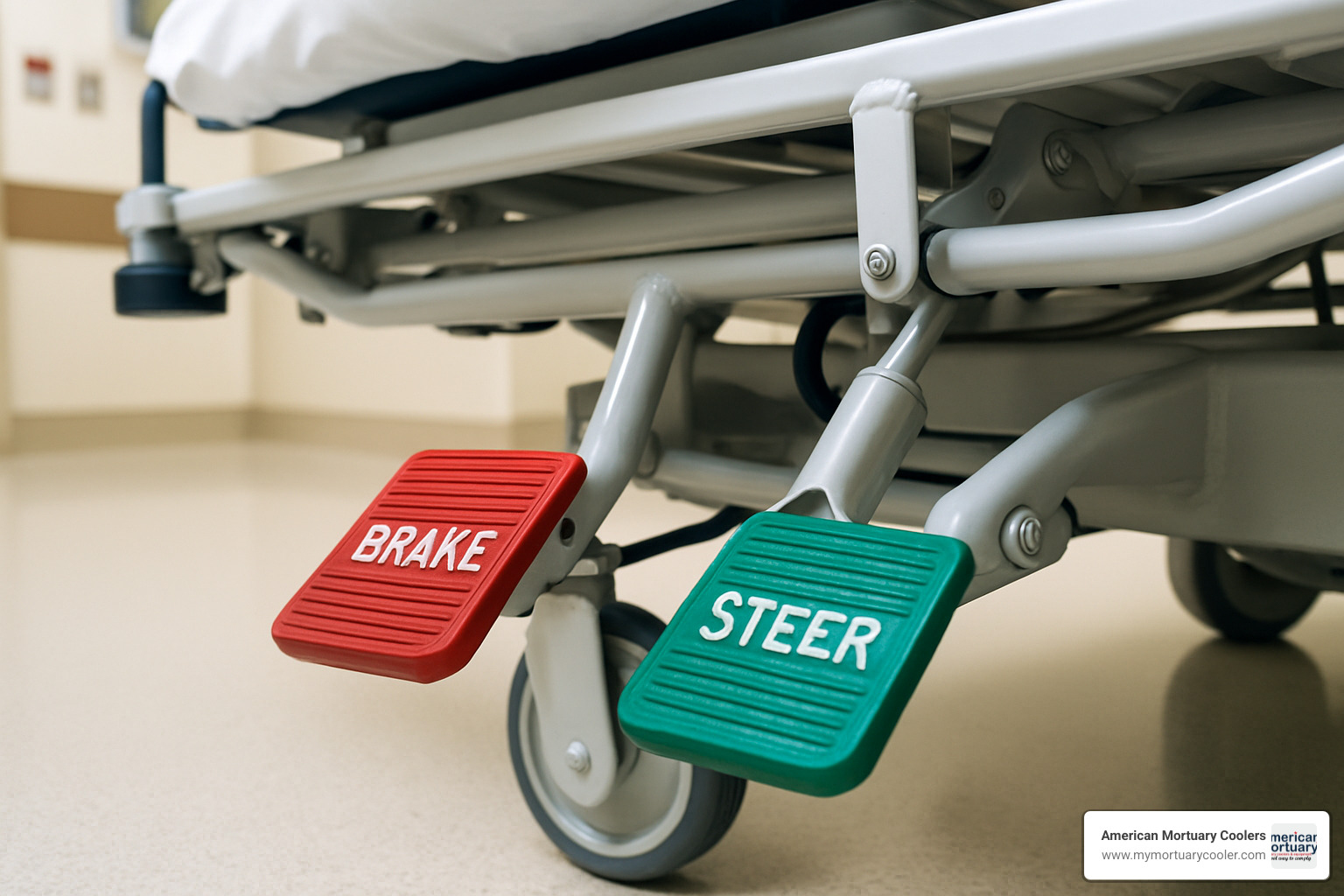
Many models now feature intuitive color-coded foot pads that make operation simple even under pressure. The red pad locks all wheels at once, the green pad releases them for movement, and a Y-shaped pad controls the directional wheel for navigating tight corners—especially helpful in crowded hospital corridors or narrow funeral home hallways.
Smart & powered stretcher bed tech
The technology in today's stretcher beds would have seemed like science fiction just a decade ago. Power-assisted models are revolutionizing patient handling:
"Powered mortuary cots with dual 20V lithium batteries have virtually eliminated back injuries among our staff," shared a funeral director from Tennessee. "Especially during those challenging home removals with stairs."
These smart features aren't just bells and whistles—they solve real problems:
Motor assist systems reduce the physical strain of raising, lowering, and moving heavier individuals. This protection works both ways, keeping both the transported person and the operators safer.
Battery technology has come a long way too. Modern stretcher beds feature convenient charging docks that ensure you're never caught with a dead battery during critical operations.
Some advanced models now incorporate weight sensors and position monitors that provide valuable data while improving safety. For hospitals and larger funeral homes, remote tracking capabilities help locate equipment quickly and schedule maintenance before problems arise.
Other innovations worth considering include central locking casters for one-touch security, antimicrobial surfaces that fight infection, modular side rails that adapt to different situations, built-in digital scales, and whisper-quiet TPR wheels that won't disturb others during transport.
When selecting a stretcher bed for your facility, think about your specific needs. A funeral home might prioritize vehicle loading features and weight capacity, while a hospital emergency department might need rapid Trendelenburg positioning and integrated scales.
For more details on selecting the perfect model, check out this quick-start guide to the best medical stretchers.
At American Mortuary Coolers, we understand that the right equipment makes all the difference in providing dignified care. We're always happy to help you steer these options to find the perfect stretcher bed for your unique situation.
Safety, Maintenance & Compliance Checklist
Let's face it – nobody gets excited about maintenance checklists, but when it comes to stretcher beds, a little attention goes a long way in keeping everyone safe and your investment protected for years to come.
Think of your stretcher bed as you would your car – regular check-ups prevent breakdowns at the worst possible moments. And in this business, those moments can truly matter.
"I've seen facilities try to squeeze an extra year out of worn equipment, only to face much bigger costs when something fails," shares our equipment specialist at American Mortuary Coolers. "A simple five-minute daily check can prevent so many headaches down the road."
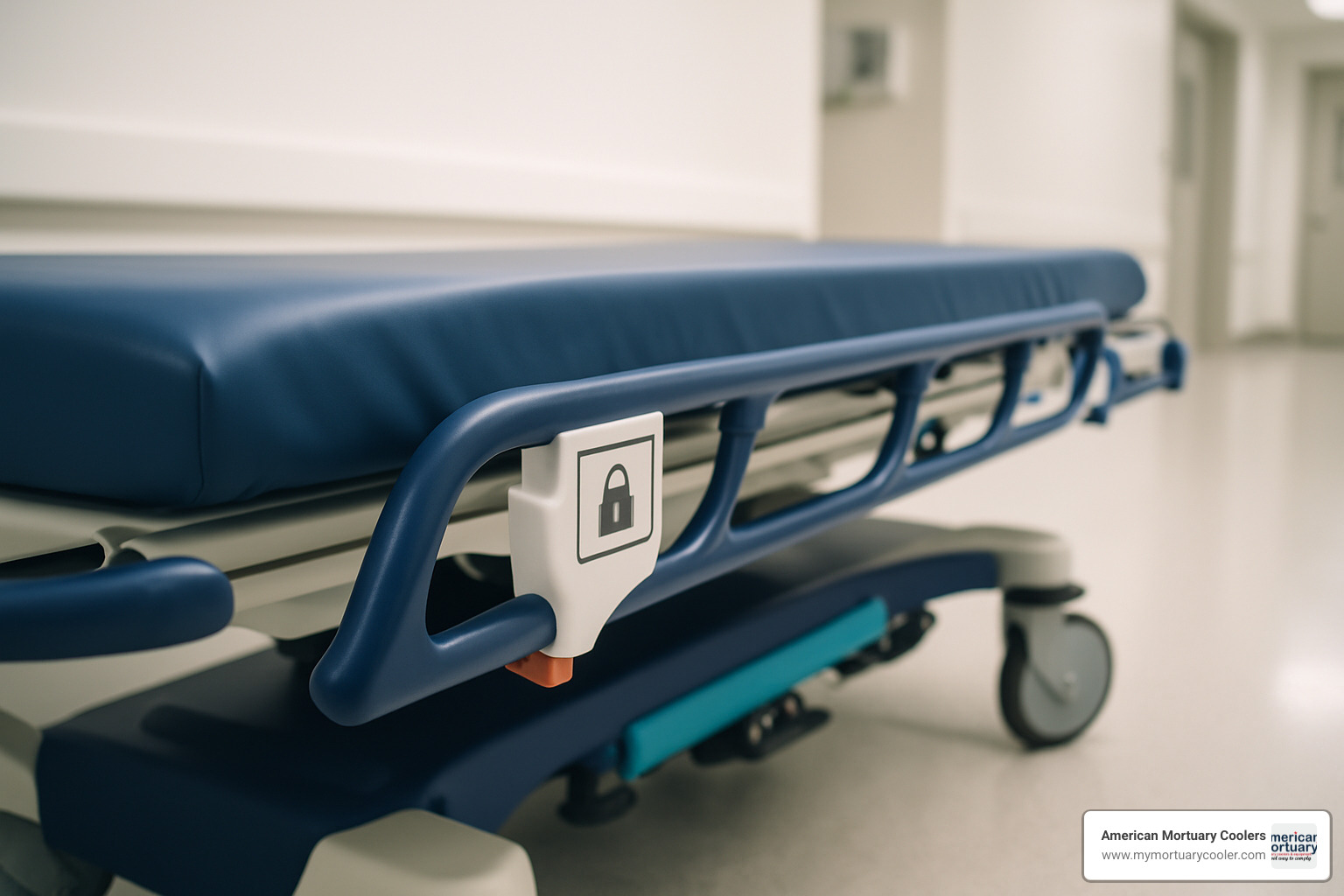
Your safety checklist should include verifying that restraint belts are intact, all locking mechanisms engage properly, and weight capacity labels remain clearly visible. Don't forget to test those side rails – they should raise smoothly and lock securely in position. The last thing you need is a rail that gives way at the wrong moment.
When it comes to compliance, your stretcher bed should meet standards like FDA approval for medical settings, CE marking for European markets, and appropriate ISO certifications. These aren't just bureaucratic hoops – they represent real safety benchmarks that protect both your staff and those in your care.
Routine cleaning & disinfection of a stretcher bed
Cleaning a stretcher bed properly isn't just about appearances – it's essential for infection control and longevity. This is especially true in mortuary settings where disinfection takes on added importance.
Start by removing any visible debris before applying appropriate cleaners. Those TPR mattress covers that make modern stretcher beds so comfortable? They typically need neutral detergents to maintain their integrity. Meanwhile, aluminum frames require non-corrosive cleaners, and UV-safe plastics need products that won't cause degradation.
"We always recommend a two-step approach," explains our specialist. "First, clean with a detergent solution to remove organic material, then follow up with an EPA-registered disinfectant that's appropriate for your specific equipment materials."
Don't rush the process – disinfectants need proper contact time to work effectively. And remember to pay special attention to handles, rails, and control mechanisms where hands frequently touch. Finally, make sure everything dries completely to prevent corrosion and microbial growth.
Periodic servicing & record keeping
Creating a maintenance schedule doesn't have to be complicated. Start with daily visual checks of critical components, then move to more thorough weekly cleanings and inspections. Monthly, take time to examine all mechanical systems more carefully.
Quarterly, it's worth having hydraulic seals checked and casters lubricated by someone with technical expertise. And annually, consider professional servicing to certify weight capacity and safety features remain up to standard.
Just as important as the maintenance itself is keeping good records. Document inspection dates, maintenance performed, parts replaced, and who performed the checks. These records aren't just good practice – they provide crucial liability protection if questions ever arise.
"The stretcher that gets the most attention lasts the longest," notes a funeral director with over 30 years of experience. "We have a stretcher bed that's been in service for 15 years because we've maintained it carefully. The upfront cost spread over that many years makes it one of our wisest investments."
By treating your stretcher bed with the care it deserves, you're not just protecting equipment – you're ensuring dignity in transport and safety for your staff. That's something worth a few minutes of maintenance time.
Forensic morgue storage stretchers: Quality solutions
How to Choose the Right Stretcher Bed for Your Facility
Finding the perfect stretcher bed for your specific needs doesn't have to be overwhelming. Whether you're running a hospital, emergency service, or funeral home, I'm here to help you steer this important decision with confidence and clarity.
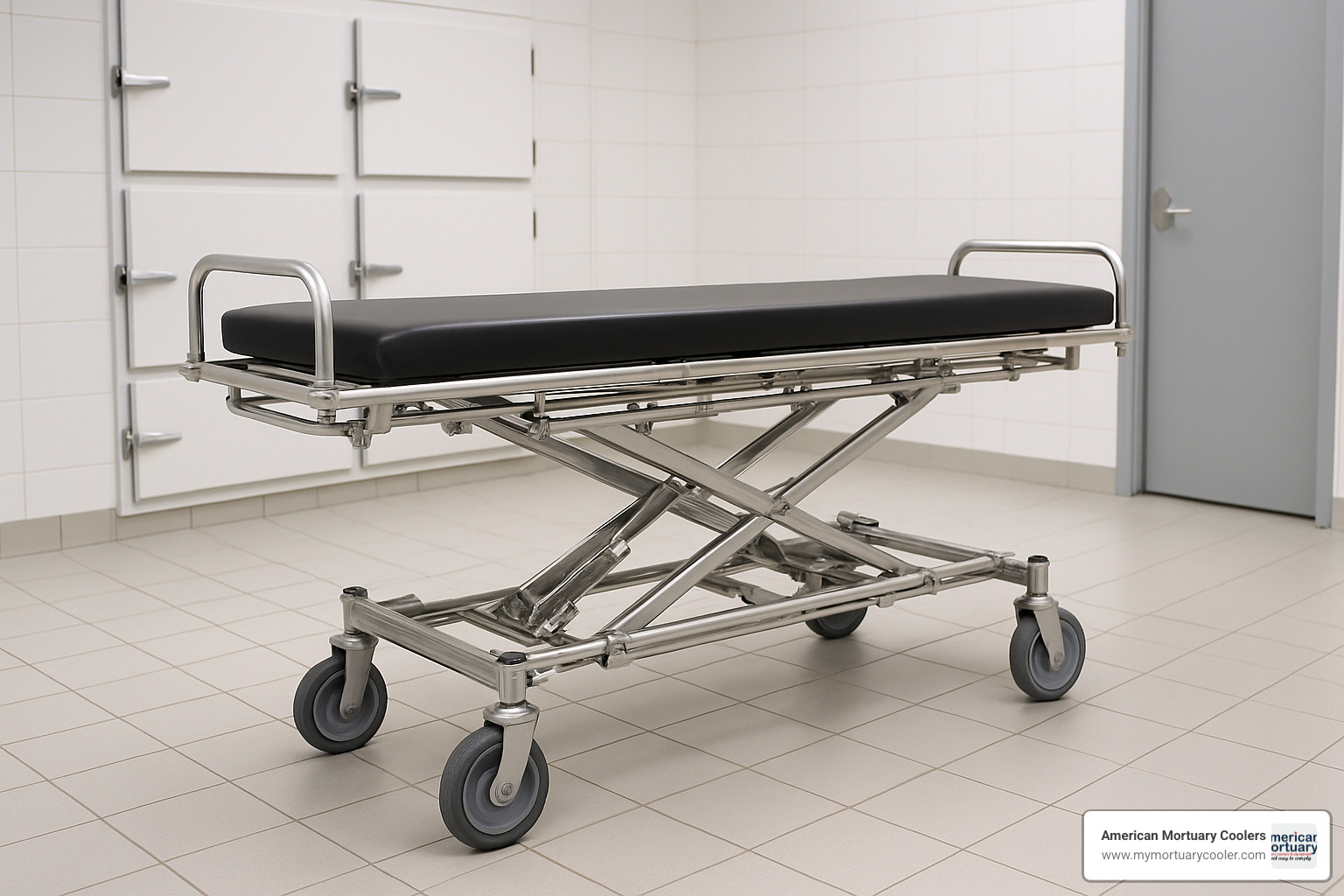
Needs assessment for a hospital stretcher bed
Hospital environments have unique demands that vary dramatically by department. In the emergency room, you'll want a stretcher bed that can move quickly and position patients efficiently—those precious minutes matter! Meanwhile, your radiology department needs something compatible with imaging equipment (those metal components can really mess with an MRI).
"When we consult with hospitals, we start by mapping their patient journey," explains our equipment specialist at American Mortuary Coolers. "Understanding exactly how and where the stretcher will be used helps identify the features that will deliver the greatest value."
Think about your patient population too. Do you serve an aging community? You might want to prioritize pressure-reducing surfaces to prevent bedsores. Got a pediatric unit? Those little ones need specialized sizing and improved safety features. And if your community has higher obesity rates (as many American communities do), appropriate bariatric options aren't just nice to have—they're essential.
Your workflow matters tremendously. A stretcher bed with built-in scales can eliminate transfer steps and speed up ER throughput. For imaging departments, radiolucent materials in key sections allow for taking X-rays without moving the patient. And don't forget about your staff! Smaller teams will thank you for powered assist features, especially during those busy overnight shifts when everyone's running on coffee and determination.
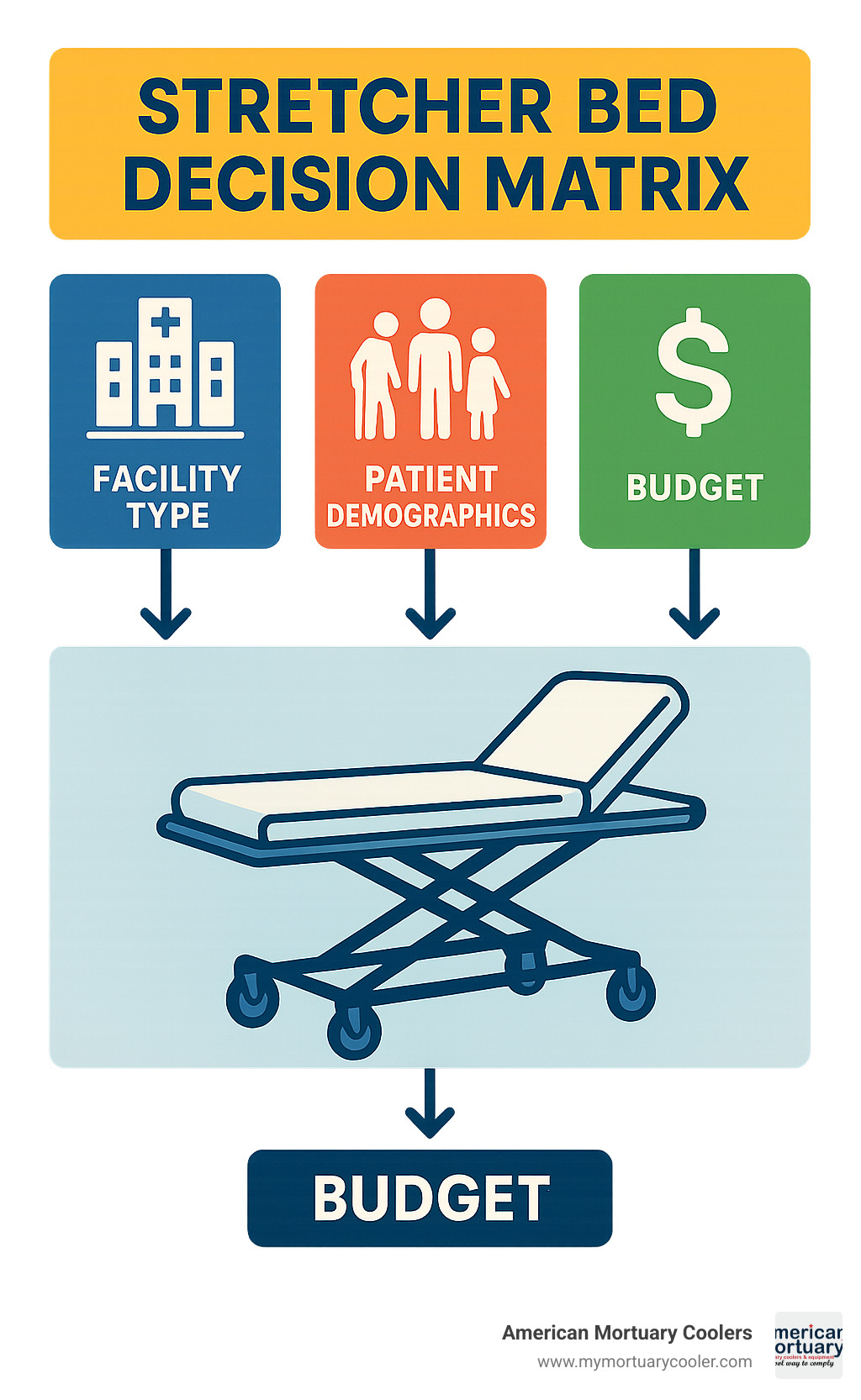
Procurement tips for funeral & mortuary stretcher bed buyers
For my friends in the funeral profession, your needs are unique and deserve special attention. Weight rating should be at the top of your consideration list. While standard mortuary cots typically support around 600 pounds, our bariatric options can exceed 1,000 pounds. Look at your community demographics honestly—having to say "we can't accommodate" is a conversation no funeral director wants to have with a grieving family.
Vehicle compatibility is non-negotiable. I've seen too many funeral homes invest in quality stretcher beds only to find they don't quite fit their removal vehicles. Measure those interior dimensions carefully, consider how the ramp works with your loading/unloading process, and verify that any locking mechanisms match your vehicle setup.
"We've found that funeral homes often focus exclusively on the stretcher itself, overlooking the value of a comprehensive system including transfer aids and accessories," notes our specialist from American Mortuary Coolers. "A quality slider board, for example, can dramatically reduce the physical strain of transfers and minimize the risk of drops."
Look for operational features that improve both dignity and efficiency. Multi-level height adjustment makes transfers smoother, extension handles add over 12 inches of reach for taller or heavier decedents, and flip-down ramps protect your vehicle bumpers during loading (a small detail that saves big on repair costs over time).
Don't forget to consider helpful accessories that complete your removal system. Slider boards with multiple grip handles make transfers safer for both your staff and the deceased. Universal side-rail attachments add flexibility to your equipment, and dignified cot pouches provide appropriate covering during transport.
When making your final decision, budget concerns need to balance initial cost against long-term value. The warranty matters—verify coverage terms, duration, and exclusions before purchasing. And don't overlook supplier support—will parts be available when you need them? Is service readily accessible? What about technical assistance when something isn't working quite right?
The cheapest option almost never delivers the best long-term value. Quality stretcher beds represent a significant investment, but they deliver returns through durability, reduced staff injuries, and improved operational efficiency. At American Mortuary Coolers, we've seen how the right equipment becomes a trusted partner in providing dignified care, day after day, year after year.
For more detailed guidance, check out The complete guide to funeral home stretchers, where we dive even deeper into making this important decision.
Frequently Asked Questions about Stretcher Beds
What weight capacity should I look for in a stretcher bed?
Choosing the right weight capacity for your stretcher bed is one of the most common questions we hear from customers. The answer really depends on who you'll be serving and how you'll use the equipment.
For general hospital and ambulance settings, standard medical stretchers typically handle between 350-500 pounds. If you're running a funeral home, standard mortuary stretchers usually support around 600 pounds, which covers most situations you'll encounter. For facilities regularly serving larger individuals, bariatric models range from 600 pounds all the way up to 1000+ pounds capacity.
"I always tell folks to think beyond just the person on the stretcher," says our equipment specialist at American Mortuary Coolers. "Remember to account for any additional equipment that might be placed alongside them. For funeral homes, we generally recommend at least a 600-pound capacity as your starting point, with bariatric options kept available for when you need them."
It's worth noting that exceeding your stretcher's weight rating isn't just risky from a safety perspective—it can void your warranty and lead to premature equipment failure. When in doubt, it's always better to go with a higher capacity. The peace of mind is worth the modest price difference.
How do adjustable stretcher beds improve caregiver safety?
The impact of adjustable stretcher beds on staff safety is remarkable, and it's something we hear about constantly from customers who've made the switch.
These stretchers protect your team in several important ways. First, they dramatically reduce lifting requirements by allowing height adjustments that minimize the need for staff to physically lift patients or decedents. This alone makes a huge difference in preventing back injuries.
The ability to set the stretcher at the perfect working height for each caregiver is another game-changer. Someone who's 5'4" and someone who's 6'2" need different working heights for optimal ergonomics—adjustable stretchers make this possible with the touch of a pedal.
Transfer safety improves tremendously too. Multi-level height adjustment lets you precisely match the height of beds, tables, or vehicles, making transfers smoother and safer for everyone involved.
"The stories we hear from funeral directors who've upgraded are pretty consistent," notes our specialist. "One director told me that before they invested in hydraulic stretchers, back injuries were their most common worker's comp claim. After switching to adjustable models, those injuries dropped by over 70%—more than paying for the higher initial cost of the equipment."
This experience aligns with formal research too. Studies in the Journal of Emergency Medical Services have shown that powered stretcher systems significantly reduce injury rates among paramedics, making them a smart investment for any operation concerned with staff wellbeing.
What is the lifespan of a well-maintained stretcher bed?
A quality stretcher bed is a long-term investment, and with proper care, you'll be surprised how many years of service you'll get.
The lifespan varies quite a bit based on construction quality and how you use and maintain the equipment. Basic canvas stretchers typically last 5-7 years with decent care. Standard hospital models will generally give you 7-10 years of reliable service with regular maintenance.
Where you really see the difference is with premium hydraulic models and heavy-duty mortuary cots. These workhorses can serve your facility for 10-15 years or even 10-20 years respectively when properly maintained.
"It really comes down to how well you care for them," explains our equipment specialist. "A high-quality stretcher that gets quarterly professional servicing can easily last 15+ years, even in busy environments. It's like taking care of a good car—regular maintenance pays off."
To get the maximum lifespan from your stretcher bed, follow the manufacturer's maintenance schedule religiously, clean properly after each use (especially important in mortuary settings), address small issues before they become big problems, and train your staff on proper handling techniques.
Many of our savvier customers implement a rotation system, moving stretchers between high and low-usage areas periodically. This helps distribute wear more evenly across their fleet and extends the overall lifespan of all their equipment.
At American Mortuary Coolers, we take pride in providing equipment that stands the test of time. We'd rather sell you one quality stretcher that lasts 15 years than three cheaper ones that fail every five years. That's just good business—for both of us.
Conclusion & Next Steps
Finding the perfect stretcher bed for your facility isn't just about buying equipment—it's about making a thoughtful investment in safety, efficiency, and dignified care. After exploring the various options and considerations in this guide, you're now armed with the knowledge to make a choice that truly fits your specific needs.
Here at American Mortuary Coolers, we take pride in our custom-built solutions for funeral professionals. Our high-quality mortuary stretchers are crafted right here in the USA, designed specifically to address the unique challenges funeral directors face daily. We understand that your equipment needs to be reliable, practical, and built to last—which is exactly what we deliver to funeral homes across the nation.
When you're ready to move forward with acquiring a stretcher bed, I recommend taking these practical steps:
First, spend some time really thinking about your specific requirements—consider the types of removals you handle most frequently and any special challenges your team faces. Next, whenever possible, try to get hands-on demonstrations of the models you're considering. There's simply no substitute for actually handling the equipment yourself.
Don't forget to involve your staff in the decision process. After all, they're the ones who'll be using this equipment day in and day out. Their insights can be invaluable in identifying features that might make their jobs easier and safer.
A stretcher bed is a long-term investment. Developing a solid maintenance plan from day one will protect that investment and extend the life of your equipment considerably. And don't just think about the stretcher in isolation—consider how a comprehensive solution including transfer aids and accessories might improve your overall operations.
Our team at American Mortuary Coolers has worked with funeral homes in Tennessee, Georgia, Illinois, South Carolina, Texas, California, New York, Pennsylvania, and throughout every region of the country. This experience has given us unique insights into the diverse needs of funeral professionals nationwide, and we're happy to share that knowledge with you.
The right stretcher bed does more than just transport—it can transform your operations, reduce staff injuries, and improve the dignified care you provide to families. By choosing thoughtfully now, you'll create positive ripple effects throughout your facility for years to come.
We'd love to help you find the perfect mortuary stretcher solution for your unique situation. Our team at American Mortuary Coolers is committed to providing durable, custom equipment that truly meets your needs and improves your ability to serve families with the respect and dignity they deserve during difficult times.
For more information about our custom mortuary solutions, including stretchers designed specifically for funeral home use, reach out to us today. We're here to help you find equipment that works as hard as you do.



















